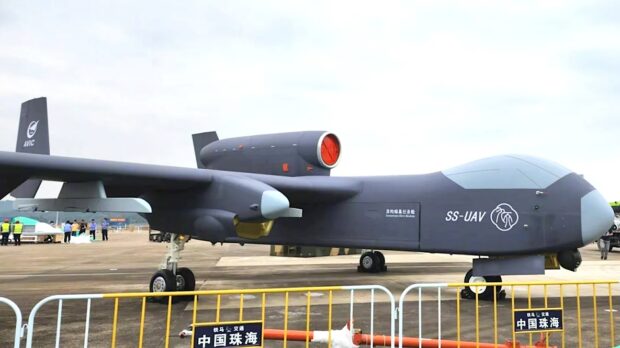Anew very large jet-powered Chinese drone said to have a 10-ton maximum takeoff weight, or a mockup thereof, has emerged ahead of the formal opening of this year’s Zhuhai Airshow. The design notably appears to be at least depicted as being fitted with a modular payload section designed to launch swarms of smaller uncrewed aerial systems.
Reportedly dubbed Jiu Tian, or “High Sky” in Chinese, the new jet drone design comes from the state-run Aviation Industry Corporation of China (AVIC). The example at Zhuhai, which officially opens next week, is also marked “SS-UAV” in Latin script. While “UAV” (uncrewed aerial vehicle) seems obvious, it is unclear what the “SS” might stand for.
The Jiu Tian has a high main wing with minimal, if any sweep and small winglets at the tips, along with an h-shaped tail. The design is powered by a single jet engine on top of its central fuselage and has a tricycle landing gear arrangement. The combination of features gives the drone, in some very broad strokes, the outward visual appearance of something of a mashup of the A-10 Warthog and OV-10 Bronco attack aircraft.
A sensor turret of the kind typically fitted with a mix of electro-optical and infrared cameras is mounted under the Jiu Tian’s nose. The drone also has a nose radome pointing to provisions for a radar inside.
As noted, there are reports that the Jiu Tian has a maximum takeoff weight of around 10 tons. For comparison, the CH-6 armed drone that emerged at Zhuhai in 2021, another relatively large jet-powered design, is said to have a maximum takeoff weight of 7.8 tons. A year later, AVIC’s Chengdu Aircraft Industry Group (CAIG) subsidiary also rolled out a new Wing Loong 3 pusher-propeller-driven armed drone, the largest member of the Wing Loong family to date, with a stated maximum takeoff weight of six tons. As another reference point, the stated maximum takeoff weight of newer extended-range versions of the U.S. MQ-9 Reaper is just under six tons.
The Jiu Tian also sports four stores pylons under each wing, though nothing is seen loaded onto them in the images that have emerged so far.
By far, the most interesting feature is the central payload section, which is labeled “Isomerism Hive Module” in English. Isomerism is a term typically used in chemistry that refers to the potential existence of isomers, which are molecules or ions with identical molecular formula, but that differ in the physical and chemical arrangements of their atoms. This appears to be something of a mistranslation of the Chinese phrase printed above on the drone, which says “ascension of the beehive mission module,” according to a machine translation. That, in turn, points strongly to the module as least being meant to reflect one capable of launching smaller drones, potentially in networked swarms.
China’s interest in swarming capabilities and the ability to launch them from various platforms, including high-altitude balloons, is not new. For military purposes, swarms have a number of inherent benefits, including the ability to rapidly fan out across a broad area to carry out various missions depending on how they are configured, including intelligence, surveillance, and reconnaissance (ISR), electronic warfare, and kinetic strike. Individual drones in a swarm can also equipped with different payloads to give the entire grouping a multi-mission capability. Large numbers of uncrewed aerial systems operating closely together also present significant challenges for defenders, who could easily find themselves overwhelmed or otherwise confused about how to best respond to the incoming threats.
The War Zone previously laid out a case for giving exactly this kind of drone swarm launch capability to reconfigured P-8 Poseidon maritime patrol planes, which you can read more about here. Drones launching other drones offers a way to push these capabilities further forward while reducing the risk to crewed platforms.
Beyond the ability to launch swarms, Jiu Tian’s underwing pylons and sensors point to the drone being designed to have onboard ISR and strike capabilities, as well. Though shown with the drone mothership module, the design appears to have a highly modular central section that could be reconfigured to give the drone other capabilities, such as additional sensor packages, air sampling systems, or even the ability to deliver certain cargoes.
More broadly speaking, Jiu Tian could give China’s armed forces a valuable additional multi-mission long-range and long-endurance uncrewed platform. Jet propulsion, in general, offers benefits when it comes to reducing transit times to and from mission areas and endurance once on station.
Though not a stealthy design, Jiu Tian presents another potentially important addition to China’s uncrewed arsenal, including in the role of drone swarm mothership.
Source: The War Zone




